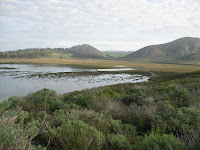

Since there were BIGBY species I needed in Atascadero and Paso Robles, I decided to pedal a 100 mile loop from my house in Los Osos, to Cerro Alto Campground, to Atascadero Lake, to Heilmann Park, to the Lewis's Woodpecker spot in northern Paso Robles (see my map) via the back roads east of Templeton, and then to home via Highway 46 and Highway 1. I had memories of the first day on my three day Carrizo Plain trip and I hoped that I wasn't pushing my cycling ablilities too far. It was going to be a long hilly ride.
I started at 7:15 AM and it was foggy with some frost on the roofs. (Bicycling gloves with the fingers cut off are not warm enough to bicycle in the cold! - I am making a list of things I have done wrong cycling and will post later) My first BIGBY species was Warbling Vireo, which was common once I left the coast. I could hear it in many spots as I pedalled up Highway 41 toward Atascadero. BIGBY bird # 2 also called from a farm on the way up. (I am not identifying this bird to see if readers of my blog can figure it out from the flight photo, shown above as the "Bird ID Challenge". It should be easy. I will post the I.D. with the comments.) Wild Turkeys were displaying in a couple of open spots along 41 and I took some photos of the competing males.
Cerro Alto was above the fog and the thick riparian habitat on the creek side of the road and the oaks on the other were noisy with bird song such as House Wren and Orange-crowned Warbler, but the only new migrant was Pacific-slope Flycatcher (BIGBY # 3) that I could hear. I stopped at San Gabriel where it crosses Highway 41, just outside of Atascadero. Purple Martins traditionally nest here, and 4 were flying around and perching in a large sycamore to the east of San Gabriel on the creek side of the highway (BIGBY # 4). I stopped at Atascadero Lake for a look-see and found a Phainopepla (pictured) in a mistletoe infested tree along with Great-tailed Grackles who were also eating the mistletoe. (Forget the proposed local bear season, how about a grackle season in San Luis Obispo County?) The wintering Cackling Goose was still present, with the domestic geese.
My next target bird was Green Heron at the ponds behind Heilmann Park and Chalk Mountain Golf Course. They are common here in the later spring, but none were visible this time. I did find two male Wood Ducks (BIGBY # 5), which would not let me get close enough for a photo. I pealed off my thermal top before leaving, but kept my light cycling jacket and leg-warmers on as there was still a cool breeze.
The route I had planned to get up to my next target bird in northern Paso Robles was a little shaky in that it had many turns with zigs and zags and I had never been that way before. On a 100 mile ride I didn't want to zig rather than zag and do many extra hilly miles. I did stop a few times to check my map on this rolling hilly route that wound through farm land and pasture, blooming with lupine, poppies, etc.
When I got to the Lewis's Woodpecker spot I found 2 of these large woodpeckers fairly quickly in this really marginal looking habitat - three old live oaks in abandoned pasture, that is quickly being developed (BIGBY # 6). I ate my lunch along the road here. (I had brought 2 sandwiches, 2 granola bars, a power bar, cashews, cup of applesauce, 3 small tangerines, and powder Gatorade for 2 bottles. I had a second lunch in Cayucos and finished it all.) After my lunch in Paso, my dessert was a flat tire! This was the tire I was going to switch to a Kevlar tire the night before, but I hate to change tires and I wanted to go to bed, so...)
I peeled off my leg warmers for the ride west on Highway 46. It was surprisingly hilly - much more so than Highway 41, but my climbs paled in comparison to the almost 5 mile constant climb that riders coming from the coast had on this highway (wow!). I saw nothing much on the ride along Highways 46 and 1, either because it was not very birdy or I was concentrating much more on the ride than on birding. I was starting to slow down as I finally hit the last big descent before the coast. I fueled up in Cayucos and had just enough energy to comfortably arrive back home at about 5:45. My BIGBY list now stood at 218. My doubts about doing a one hundred mile ride were gone! However, it turned out that one hundred miles in a day was too far me to cycle, bird, and photograph. I just did not have enough time to photograph, but did see most of my target birds.






































